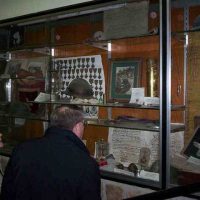The museum presents many heart-rending objects which would have been forgotten or destroyed if Father Comby had not saved them. Formerly known under the name of ” TheMuseum of Memory ” preserving the relics of the soldier priestsof the 1914 – 1918 war in the crypt of the Church of the GuardianAngels of Saint-Maurice, this material was transmitted by the parish toFather Alain as an ordination present. Since then, we have addedsome of the objects which Father Revet left us.
Everything here speaks to us about Faith.
First of all, there is the soldier-priest’s garment, gilded on oneside and black on the other, a garment which it sufficed to turn inside outto celebrate the office for the dead, the day after too short a truce, after the solemnities of Easter or of the Nativity. One thinkswith emotion of these Midnight masses, celebrated in the snow and the cold on both sides of the front.
On these gilded embroideries lingers the feverish glance of hundreds of soldiers. French? German? On both sides prayers were said to the Holy Child that the fatal combat might one day cease. Butthe following day’s attack reaped its harvest of victims amongst therows of yesterday’s faithful. Almost every day, the priest celebratedMass for the departed, for the combatants at whose death he had been present in the shell-holes, under the constant deluge of iron and fire, at the peril of hisown life. À portable altar, identical to those used in the trenches by the soldier-priests makes it possible toimagine the celebration of Holy Communion under such precarious conditions. À chalice, engraved 1914 -1918 shortly after war, recalls theaction of grace of a priest who survived this terrible apostolate.
À panoply of more than sixty Military Crosses awarded tomilitary chaplains points out their splendid epic which oftenforced the admiration even of unbelievers. À chaplain’s quotation goes with each cross.
À fatal epic since 4600 cassocks lost their lives during the fighting, priests, deacons, seminarists whose surplus became an early shroud. Priests going up towards a new Golgotha, crossing the battle field, priests fallen as apostles. Old photographs and postcards tell thelife of the chaplains in the trenches. À small booklet printed inGothic script delivers the homilies of a German chaplain.
In a small show case can be seen various objects which belonged to aCanadian soldier of Vimy : a piece of fabric from his jacket, a pipe, anEnglish-French dictionary, his forks and spoons, his rosary beads. Many (inoffensive) grenades and shell heads found on theFlanders and Artois front show off these vestiges of the prayer ofThe soldiers and speak to the imagination of our visitors of the harshness of the fighting.
À little further on, objects found in the ground ofRiaumont, during the building of the Village, like this copper oil lamp and these very rusted rifles, remind us that our hill ofRiaumont was, for three long years, right in the heart of the battle. Thus these relics of the great war have found their place again on the very site of their epic. The battle field of Riaumont, now aChildren’s Village, a garden of flowers, a haven of peace, is the providentialreliquary which makes it possible to expose these objects to the eyes ofthe children of France, so that they do not forget.
Since the Fire of Saint Jean in 1994, when themuseum was opened to public, the same interest and emotion has always been seen in the eyes of our visitors, who in front of these show cases, become pilgrims.
The stained glass of the crypt of Saint Maurice has still to be restored, other objects belonging to priests of the second world war and to missionnaires have to be put into place, this already impressive collection has to be developped by adding new donations.


